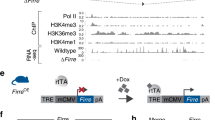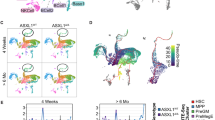Abstract
Ets-related gene (ERG), which encodes a member of the Ets family of transcription factors, is a potent oncogene. Chromosomal rearrangements involving ERG are found in acute myeloid leukemia, acute lymphoblastic leukemia, Ewing's sarcoma and more than half of all prostate cancers; however, the normal physiological function of Erg is unknown. We did a sensitized genetic screen of the mouse for regulators of hematopoietic stem cell function and report here a germline mutation of Erg. We show that Erg is required for definitive hematopoiesis, adult hematopoietic stem cell function and the maintenance of normal peripheral blood platelet numbers.
This is a preview of subscription content, access via your institution
Access options
Subscribe to this journal
Receive 12 print issues and online access
$209.00 per year
only $17.42 per issue
Buy this article
- Purchase on Springer Link
- Instant access to full article PDF
Prices may be subject to local taxes which are calculated during checkout







Similar content being viewed by others
Accession codes
References
Cheng, J. et al. Hematopoietic defects in mice lacking the sialomucin CD34. Blood 87, 479–490 (1996).
Antonchuk, J., Hyland, C.D., Hilton, D.J. & Alexander, W.S. Synergistic effects on erythropoiesis, thrombopoiesis, and stem cell competitiveness in mice deficient in thrombopoietin and steel factor receptors. Blood 104, 1306–1313 (2004).
Ballmaier, M. et al. c-mpl mutations are the cause of congenital amegakaryocytic thrombocytopenia. Blood 97, 139–146 (2001).
Ihara, K. et al. Identification of mutations in the c-mpl gene in congenital amegakaryocytic thrombocytopenia. Proc. Natl. Acad. Sci. USA 96, 3132–3136 (1999).
Kimura, S., Roberts, A.W., Metcalf, D. & Alexander, W.S. Hematopoietic stem cell deficiencies in mice lacking c-Mpl, the receptor for thrombopoietin. Proc. Natl. Acad. Sci. USA 95, 1195–1200 (1998).
Hrabe de Angelis, M.H. et al. Genome-wide, large-scale production of mutant mice by ENU mutagenesis. Nat. Genet. 25, 444–447 (2000).
Kile, B.T. et al. Functional genetic analysis of mouse chromosome 11. Nature 425, 81–86 (2003).
Nelms, K.A. & Goodnow, C.C. Genome-wide ENU mutagenesis to reveal immune regulators. Immunity 15, 409–418 (2001).
Nolan, P.M. et al. A systematic, genome-wide, phenotype-driven mutagenesis programme for gene function studies in the mouse. Nat. Genet. 25, 440–443 (2000).
Duterque-Coquillaud, M., Niel, C., Plaza, S. & Stehelin, D. New human erg isoforms generated by alternative splicing are transcriptional activators. Oncogene 8, 1865–1873 (1993).
Shimizu, K. et al. An ets-related gene, ERG, is rearranged in human myeloid leukemia with t(16;21) chromosomal translocation. Proc. Natl. Acad. Sci. USA 90, 10280–10284 (1993).
Sorensen, P.H. et al. A second Ewing's sarcoma translocation, t(21;22), fuses the EWS gene to another ETS-family transcription factor, ERG. Nat. Genet. 6, 146–151 (1994).
Baldus, C.D. et al. Acute myeloid leukemia with complex karyotypes and abnormal chromosome 21: Amplification discloses overexpression of APP, ETS2, and ERG genes. Proc. Natl. Acad. Sci. USA 101, 3915–3920 (2004).
Marcucci, G. et al. Overexpression of the ETS-related gene, ERG, predicts a worse outcome in acute myeloid leukemia with normal karyotype: a Cancer and Leukemia Group B study. J. Clin. Oncol. 23, 9234–9242 (2005).
Mullighan, C.G. et al. Genome-wide analysis of genetic alterations in acute lymphoblastic leukaemia. Nature 446, 758–764 (2007).
Tomlins, S.A. et al. Distinct classes of chromosomal rearrangements create oncogenic ETS gene fusions in prostate cancer. Nature 448, 595–599 (2007).
Tomlins, S.A. et al. Recurrent fusion of TMPRSS2 and ETS transcription factor genes in prostate cancer. Science 310, 644–648 (2005).
Alexander, W.S., Roberts, A.W., Nicola, N.A., Li, R. & Metcalf, D. Deficiencies in progenitor cells of multiple hematopoietic lineages and defective megakaryocytopoiesis in mice lacking the thrombopoietic receptor c-Mpl. Blood 87, 2162–2170 (1996).
Reddy, E.S. & Rao, V.N. Erg, an ets-related gene, codes for sequence-specific transcriptional activators. Oncogene 6, 2285–2289 (1991).
Liang, H. et al. Solution structure of the ets domain of Fli-1 when bound to DNA. Nat. Struct. Biol. 1, 871–875 (1994).
Andersson, L.C., Nilsson, K. & Gahmberg, C.G. K562–a human erythroleukemic cell line. Int. J. Cancer 23, 143–147 (1979).
Rainis, L. et al. The proto-oncogene ERG in megakaryoblastic leukemias. Cancer Res. 65, 7596–7602 (2005).
Carrere, S., Verger, A., Flourens, A., Stehelin, D. & Duterque-Coquillaud, M. Erg proteins, transcription factors of the Ets family, form homo, heterodimers and ternary complexes via two distinct domains. Oncogene 16, 3261–3268 (1998).
Spyropoulos, D.D. et al. Hemorrhage, impaired hematopoiesis, and lethality in mouse embryos carrying a targeted disruption of the Fli1 transcription factor. Mol. Cell. Biol. 20, 5643–5652 (2000).
Hart, A. et al. Fli-1 is required for murine vascular and megakaryocytic development and is hemizygously deleted in patients with thrombocytopenia. Immunity 13, 167–177 (2000).
Loder, F. et al. B cell development in the spleen takes place in discrete steps and is determined by the quality of B cell receptor-derived signals. J. Exp. Med. 190, 75–89 (1999).
Anderson, M.K., Hernandez-Hoyos, G., Diamond, R.A. & Rothenberg, E.V. Precise developmental regulation of Ets family transcription factors during specification and commitment to the T cell lineage. Development 126, 3131–3148 (1999).
Okada, S. et al. In vivo and in vitro stem cell function of c-kit- and Sca-1-positive murine hematopoietic cells. Blood 80, 3044–3050 (1992).
Kiel, M.J. et al. SLAM family receptors distinguish hematopoietic stem and progenitor cells and reveal endothelial niches for stem cells. Cell 121, 1109–1121 (2005).
Yang, L. et al. Identification of Lin−Sca1+kit+CD34+Flt3− short-term hematopoietic stem cells capable of rapidly reconstituting and rescuing myeloablated transplant recipients. Blood 105, 2717–2723 (2005).
Buttice, G. et al. Erg, an Ets-family member, differentially regulates human collagenase1 (MMP1) and stromelysin1 (MMP3) gene expression by physically interacting with the Fos/Jun complex. Oncogene 13, 2297–2306 (1996).
McLaughlin, F. et al. Combined genomic and antisense analysis reveals that the transcription factor Erg is implicated in endothelial cell differentiation. Blood 98, 3332–3339 (2001).
Pimanda, J.E. et al. Endoglin expression in the endothelium is regulated by Fli-1, Erg, and Elf-1 acting on the promoter and a -8-kb enhancer. Blood 107, 4737–4745 (2006).
Forsberg, E.C. et al. Differential expression of novel potential regulators in hematopoietic stem cells. PLoS Genet. 1, e28 (2005).
Bryder, D., Rossi, D.J. & Weissman, I.L. Hematopoietic stem cells: the paradigmatic tissue-specific stem cell. Am. J. Pathol. 169, 338–346 (2006).
Okuda, T., van Deursen, J., Hiebert, S.W., Grosveld, G. & Downing, J.R. AML1, the target of multiple chromosomal translocations in human leukemia, is essential for normal fetal liver hematopoiesis. Cell 84, 321–330 (1996).
Nottingham, W.T. et al. Runx1-mediated hematopoietic stem cell emergence is controlled by a Gata/Ets/SCL-regulated enhancer. Blood 110, 4188–4197 (2007).
Hollenhorst, P.C., Shah, A.A., Hopkins, C. & Graves, B.J. Genome-wide analyses reveal properties of redundant and specific promoter occupancy within the ETS gene family. Genes Dev. 21, 1882–1894 (2007).
Ichikawa, M. et al. AML-1 is required for megakaryocytic maturation and lymphocytic differentiation, but not for maintenance of hematopoietic stem cells in adult hematopoiesis. Nat. Med. 10, 299–304 (2004).
Pimanda, J.E. et al. Gata2, Fli1, and Scl form a recursively wired gene-regulatory circuit during early hematopoietic development. Proc. Natl. Acad. Sci. USA 104, 17692–17697 (2007).
Robb, L. et al. Absence of yolk sac hematopoiesis from mice with a targeted disruption of the scl gene. Proc. Natl. Acad. Sci. USA 92, 7075–7079 (1995).
Shivdasani, R.A., Mayer, E.L. & Orkin, S.H. Absence of blood formation in mice lacking the T-cell leukaemia oncoprotein tal-1/SCL. Nature 373, 432–434 (1995).
Porcher, C. et al. The T cell leukemia oncoprotein SCL/tal-1 is essential for development of all hematopoietic lineages. Cell 86, 47–57 (1996).
Mikkola, H.K. et al. Haematopoietic stem cells retain long-term repopulating activity and multipotency in the absence of stem-cell leukaemia SCL/tal-1 gene. Nature 421, 547–551 (2003).
Hitzler, J.K. & Zipursky, A. Origins of leukaemia in children with Down syndrome. Nat. Rev. Cancer 5, 11–20 (2005).
Hitzler, J.K., Cheung, J., Li, Y., Scherer, S.W. & Zipursky, A. GATA1 mutations in transient leukemia and acute megakaryoblastic leukemia of Down syndrome. Blood 101, 4301–4304 (2003).
Mundschau, G. et al. Mutagenesis of GATA1 is an initiating event in Down syndrome leukemogenesis. Blood 101, 4298–4300 (2003).
Wechsler, J. et al. Acquired mutations in GATA1 in the megakaryoblastic leukemia of Down syndrome. Nat. Genet. 32, 148–152 (2002).
Miyoshi, H. et al. t(8;21) breakpoints on chromosome 21 in acute myeloid leukemia are clustered within a limited region of a single gene, AML1. Proc. Natl. Acad. Sci. USA 88, 10431–10434 (1991).
Kirsammer, G. et al. Highly penetrant myeloproliferative disease in the Ts65Dn mouse model of Down syndrome. Blood 111, 767–775 (2007).
Bode, V.C. Ethylnitrosourea mutagenesis and the isolation of mutant alleles for specific genes located in the T region of mouse chromosome 17. Genetics 108, 457–470 (1984).
O'Reilly, L.A. et al. Tissue expression and subcellular localization of the pro-survival molecule Bcl-w. Cell Death Differ. 8, 486–494 (2001).
Alexander, W.S., Metcalf, D. & Dunn, A.R. Point mutations within a dimer interface homology domain of c-Mpl induce constitutive receptor activity and tumorigenicity. EMBO J. 14, 5569–5578 (1995).
Darzynkiewicz, Z., Juan, G. & Srour, E. in Current Protocols in Cytometry. (ed. Robinson, J.P.) 7.3.1–7.3.16 (John Wiley and Sons, Hoboken, NJ, 2004).
Voss, A.K., Thomas, T. & Gruss, P. Mice lacking HSP90β fail to develop a placental labyrinth. Development 127, 1–11 (2000).
Ma, Q., Chen, Z., del Barco Barrantes, I., de la Pompa, J.L. & Anderson, D.J. neurogenin1 is essential for the determination of neuronal precursors for proximal cranial sensory ganglia. Neuron 20, 469–482 (1998).
Lin, S.M., Du, P., Huber, W. & Kibbe, W.A. Model-based variance-stabilizing transformation for Illumina microarray data. Nucleic Acids Res. 36, e11 (2008).
Smyth, G.K. Linear models and empirical bayes methods for assessing differential expression in microarray experiments. Stat. Appl. Genet. Mol. Biol. 3 Issue 1, Article 3 (2004).
Acknowledgements
We thank J. Corbin and J. Lochland for technical assistance; S. Guzzardi, S. Ross, M. Salzone, C. Evans, P. Pavlidis and K. Trueman for animal husbandry; and D.K. Watson (Medical University of South Carolina) for mice with deletion of the Fli-1 activation domain. Supported by the National Health and Medical Research Council of Australia (grants 461219 and 516726; fellowships to D.J.H., W.S.A. and D.F.H.), the Australian Stem Cell Centre (project 047), the Australian Phenomics Network, the Australian Research Council (B.T.K.), the Australian Department of Education, Science and Training (S.J.L. and C.A.d.G.), the University of Melbourne (E.A.K.), the Cancer Council of Victoria (D.M.) and MuriGen Therapeutics.
Author information
Authors and Affiliations
Contributions
S.J.L., D.J.H., W.S.A. and B.T.K. designed and did research, analyzed data and wrote the paper; A.K.V. and D.M. designed and did research and analyzed data; E.A.K., D.F.H., C.A.d.G., C.D.H. and S.E. did research and analyzed data; and T.A.W. and K.J.H. did research.
Corresponding author
Ethics declarations
Competing interests
This work was supported by MuriGen Therapeutics, in which D.J.H., W.S.A. and B.T.K. hold equity and for which they consult.
Supplementary information
Supplementary Text and Figures
Supplementary Figure 1 and Supplementary Tables 1–3 (PDF 429 kb)
Rights and permissions
About this article
Cite this article
Loughran, S., Kruse, E., Hacking, D. et al. The transcription factor Erg is essential for definitive hematopoiesis and the function of adult hematopoietic stem cells. Nat Immunol 9, 810–819 (2008). https://doi.org/10.1038/ni.1617
Received:
Accepted:
Published:
Issue Date:
DOI: https://doi.org/10.1038/ni.1617
This article is cited by
-
The NCOR-HDAC3 co-repressive complex modulates the leukemogenic potential of the transcription factor ERG
Nature Communications (2023)
-
21q22 amplification detection in three patients with acute myeloid leukemia: cytogenomic profiling and literature review
Molecular Cytogenetics (2022)
-
PGC1 alpha coactivates ERG fusion to drive antioxidant target genes under metabolic stress
Communications Biology (2022)
-
The roles of ETS transcription factors in liver fibrosis
Human Cell (2022)
-
Clonal hematopoiesis of indeterminate potential, DNA methylation, and risk for coronary artery disease
Nature Communications (2022)



